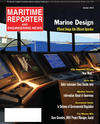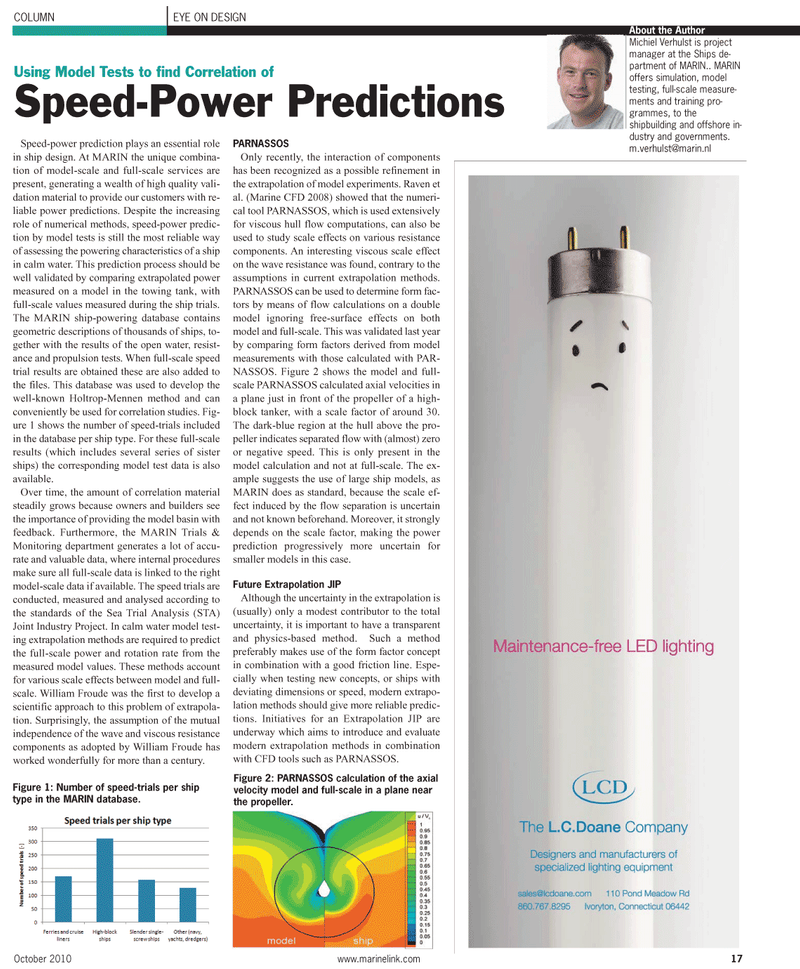
Page 17: of Maritime Reporter Magazine (February 2, 2010)
Read this page in Pdf, Flash or Html5 edition of February 2, 2010 Maritime Reporter Magazine
Speed-power prediction plays an essential role in ship design. At MARIN the unique combina- tion of model-scale and full-scale services are present, generating a wealth of high quality vali- dation material to provide our customers with re- liable power predictions. Despite the increasing role of numerical methods, speed-power predic- tion by model tests is still the most reliable way of assessing the powering characteristics of a ship in calm water. This prediction process should be well validated by comparing extrapolated power measured on a model in the towing tank, with full-scale values measured during the ship trials.
The MARIN ship-powering database contains geometric descriptions of thousands of ships, to- gether with the results of the open water, resist- ance and propulsion tests. When full-scale speed trial results are obtained these are also added to the files. This database was used to develop the well-known Holtrop-Mennen method and can conveniently be used for correlation studies. Fig- ure 1 shows the number of speed-trials included in the database per ship type. For these full-scale results (which includes several series of sister ships) the corresponding model test data is also available.
Over time, the amount of correlation material steadily grows because owners and builders see the importance of providing the model basin with feedback. Furthermore, the MARIN Trials &
Monitoring department generates a lot of accu- rate and valuable data, where internal procedures make sure all full-scale data is linked to the right model-scale data if available. The speed trials are conducted, measured and analysed according to the standards of the Sea Trial Analysis (STA)
Joint Industry Project. In calm water model test- ing extrapolation methods are required to predict the full-scale power and rotation rate from the measured model values. These methods account for various scale effects between model and full- scale. William Froude was the first to develop a scientific approach to this problem of extrapola- tion. Surprisingly, the assumption of the mutual independence of the wave and viscous resistance components as adopted by William Froude has worked wonderfully for more than a century.
PARNASSOS
Only recently, the interaction of components has been recognized as a possible refinement in the extrapolation of model experiments. Raven et al. (Marine CFD 2008) showed that the numeri- cal tool PARNASSOS, which is used extensively for viscous hull flow computations, can also be used to study scale effects on various resistance components. An interesting viscous scale effect on the wave resistance was found, contrary to the assumptions in current extrapolation methods.
PARNASSOS can be used to determine form fac- tors by means of flow calculations on a double model ignoring free-surface effects on both model and full-scale. This was validated last year by comparing form factors derived from model measurements with those calculated with PAR-
NASSOS. Figure 2 shows the model and full- scale PARNASSOS calculated axial velocities in a plane just in front of the propeller of a high- block tanker, with a scale factor of around 30.
The dark-blue region at the hull above the pro- peller indicates separated flow with (almost) zero or negative speed. This is only present in the model calculation and not at full-scale. The ex- ample suggests the use of large ship models, as
MARIN does as standard, because the scale ef- fect induced by the flow separation is uncertain and not known beforehand. Moreover, it strongly depends on the scale factor, making the power prediction progressively more uncertain for smaller models in this case.
Future Extrapolation JIP
Although the uncertainty in the extrapolation is (usually) only a modest contributor to the total uncertainty, it is important to have a transparent and physics-based method. Such a method preferably makes use of the form factor concept in combination with a good friction line. Espe- cially when testing new concepts, or ships with deviating dimensions or speed, modern extrapo- lation methods should give more reliable predic- tions. Initiatives for an Extrapolation JIP are underway which aims to introduce and evaluate modern extrapolation methods in combination with CFD tools such as PARNASSOS.
COLUMN EYE ON DESIGN
Using Model Tests to find Correlation of
Speed-Power Predictions
About the Author
Michiel Verhulst is project manager at the Ships de- partment of MARIN.. MARIN offers simulation, model testing, full-scale measure- ments and training pro- grammes, to the shipbuilding and offshore in- dustry and governments. [email protected]
Figure 2: PARNASSOS calculation of the axial velocity model and full-scale in a plane near the propeller.
Figure 1: Number of speed-trials per ship type in the MARIN database.
October 2010 www.marinelink.com 17

 16
16

 18
18
